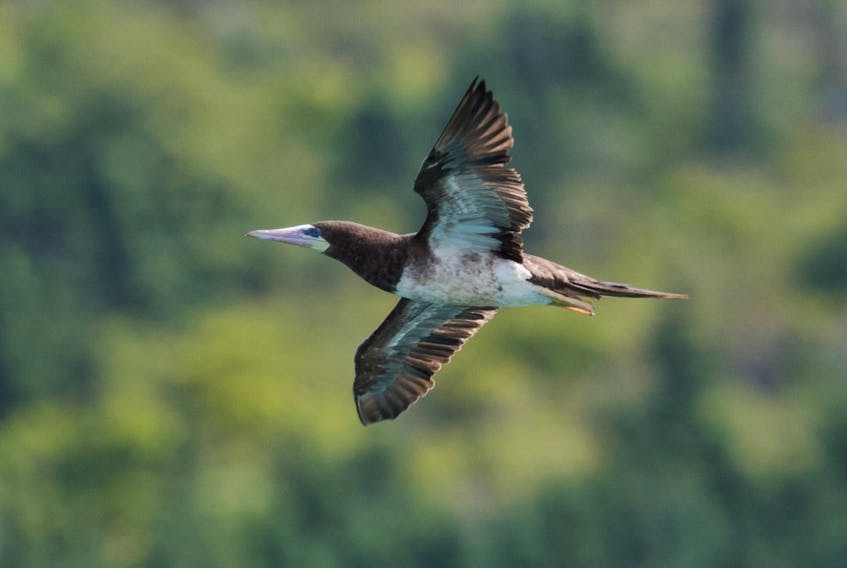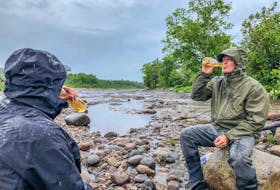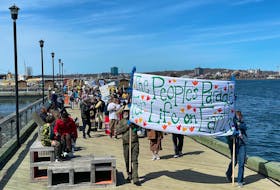It was Saturday morning. I was looking for warblers in the rich alder beds on the west side of Trepassey harbour when the cellphone rang. It was Cliff Doran. He said someone posted a picture of a bird on Facebook that sure looks like one of those brown boobies. It was sitting on the mast of a boat at Pier 7. My questions were what Pier 7, and when was the picture taken? By the time I got to Cliff’s house hardly five minutes away to see the pictures, Cliff had all the answers.
It was Glenn Burry who photographed the brown booby that morning at Pier 7 in St. John’s harbour. And the bird was still there! Before Cliff could offer cake and coffee I was through the door and began the race back to town.

I knew Pier 7 was somewhere behind The Keg restaurant in St. John’s. It was no trouble to tell where the bird was by the small crowd of people with cameras, telescopes and binoculars. I jumped out of the car with my binoculars and camera.
The brown booby was sitting on the tip of a mast sticking off the roof of a small vessel called the Norcon Oceanus. It rested there calmly preening and basically ignoring the birdwatchers below and all traffic noise and commotion on nearby Harbour Drive. I hardly had my camera set up when it stretched its wings and went to wing. It circled the inner harbour twice and then flew east. Presumably it kept going right out of the harbour because it could not be found anymore that day or the next. I thanked my lucky stars. Had I been 10 minutes later I would have missed it.
There is a growing story with the brown booby.
The brown booby is a tropical seabird. It normally lives in hot areas where the ocean temperature hovers around 26-28°C. About 15 years ago birders along the east coast of the United States started seeing brown boobies during the summer. Then Newfoundland got its first brown booby in July 2012 when one decided to land on a tour boat out of St. Anthony.
Every summer since then one or more brown boobies has been reported in Newfoundland waters and at least twice in Labrador.
Nearly all the reports were of individuals perched on a boat, usually well offshore. Being a tame bird by nature they are easy to photograph with a cell phone. However, the general birding populace was not seeing them.
The news of a brown booby in St. John’s harbour spread like wildfire through the various means of modern technology.
Everyone who was around was there plus a good many curious passersby wondering what that bird was teed up on the mast.
There are nine species of booby on this planet. They all live in warm tropical oceans.
Boobies are related to gannets. The brown booby is smaller and lighter on the wing than our gannet. They eat similar foods so no doubt a brown booby does fine for itself during the Newfoundland summer dining on small fish and squid.
Unlike the gannet, boobies prefer to sit on dry objects even when at sea. The masts of ships are often chosen as a place of sanctuary.
Why brown boobies are becoming so regular in the cold waters of the North Atlantic is a mystery. Perhaps the feeding in their Caribbean home land is not so good so they are exploring northward.
There is so much I could talk about for this week’s column and so little space.
The big event was hurricane Dorian. It took its time moving from Florida to Cape Hatteras, North Carolina but Dorian exited Hatteras at a gallop and crashed head on into Nova Scotia. It weakened after exiting out the other side of Nova Scotia and then travelled up through the Strait of Belle Isle.
Cameras on a weather buoy off the Carolinas showed there were great numbers of birds caught within the eye of the storm. Dorian dumped unprecedented numbers of storm waifs on Nova Scotia.
There were many hundreds of laughing gulls, many rare southern terns, scores of black skimmers as well as large flocks of swallows and shorebirds. Many of these birds were in very rough shape by the time they found the refuge on land perhaps having been in the hurricane eye for several days without food.
The edge of storm touched the southwest corner of Newfoundland.
Alvan Buckley was there when it arrived with all its ferocity. He found three gull-billed terns, nine black terns and three laughing gulls. There were only two previous records of gull-billed tern in the province. As this goes to the printer, more rare terns and the province’s first marbled godwit were found by Dave Brown at Stephenville Crossing.
This story is still unfolding.
Bruce Mactavish is an environmental consultant and avid birdwatcher. He can be reached at [email protected].
RELATED:









